Estonian Music Days – day one, introducing a vibrant music scene
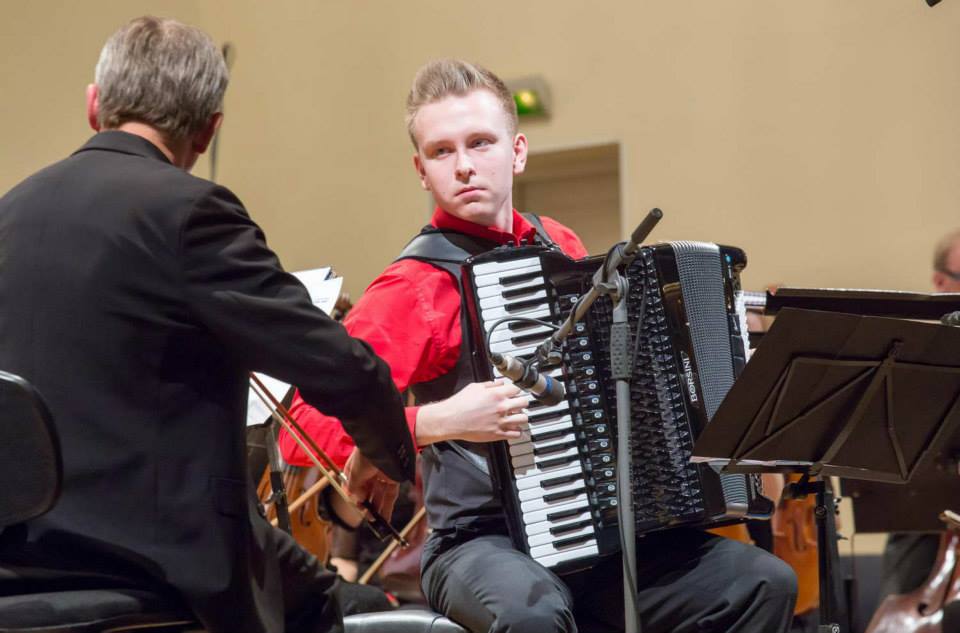
Opening concert of the Estonian Music Days is fine showcase
Having been in Istanbul last month, I was in a very different but equally historic place last weekend (10-12 April) when I attended theEstonian Music Days (Eesti Muusika Paevad) in Tallinn, a festival of Estonian contemporary music organised by the Estonian Composers Union (Eesti Heliloojate Liit). The artistic directors of the festival this year are Helena Tulve and Timo Steiner, and over the course of three days I attended five events, all comprising contemporary music with many world premieres, by predominantly Estonian composers. Tallinn is a very historic city and the festival used a wide variety of venues.
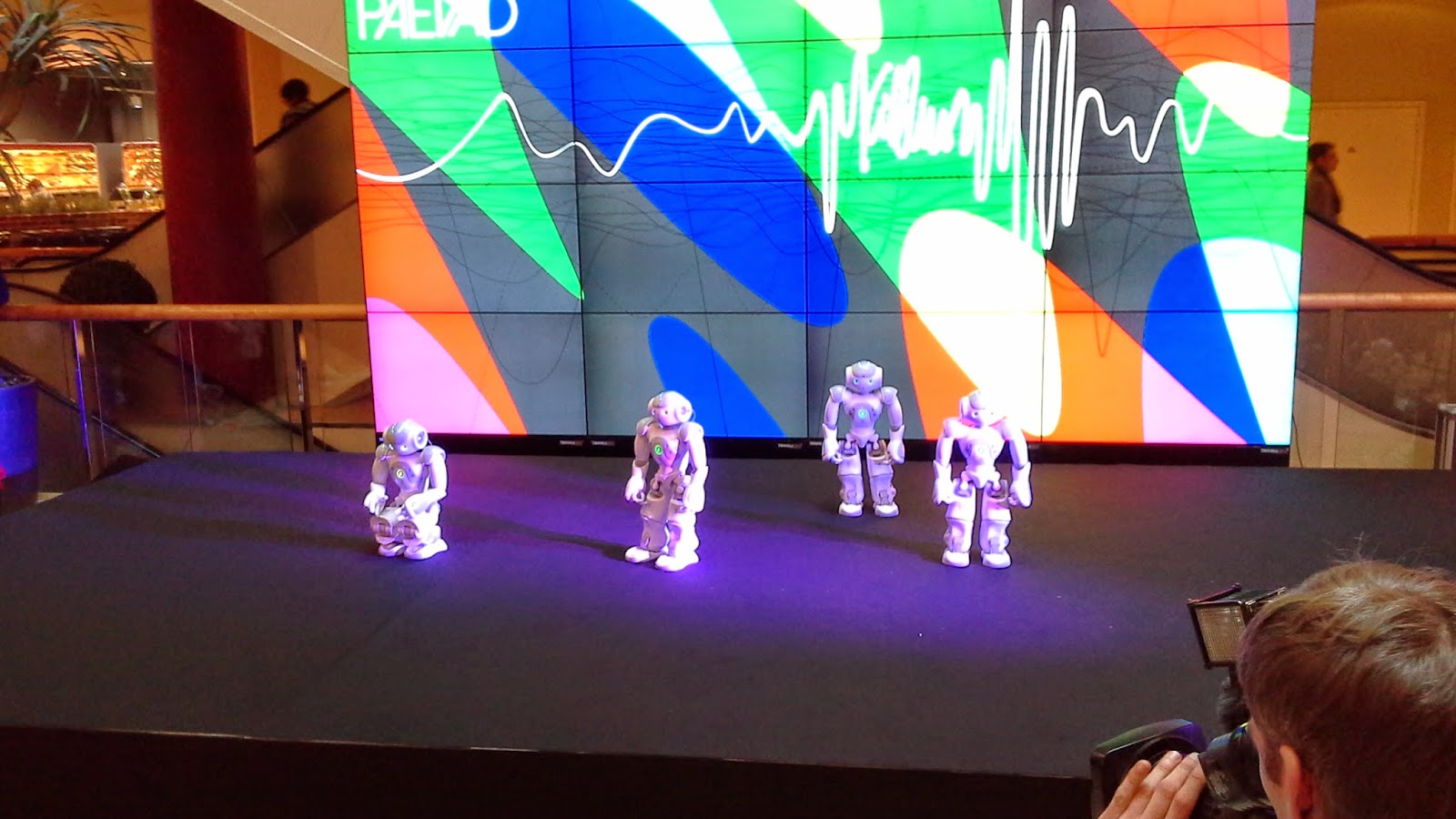 |
| Mini-EMD – Dancing robots at Solaris in Timo Steiner’s Stuck in a Loop – photo Robert Hugill |
In parallel with the main festival there was also Mini-EMD which was curated and organised by a team of young people (secondary school age). The first event (on Friday 10 April 2015) that I attended was in the shopping centre, Solaris, where amidst the shoppers coming and going and the smell of fruit and vegetables, a group of robots performed Timo Steiner‘s Stuck in a Loop. The humanoid robots, each named after a philosopher, moved as well as making sounds so that it was almost a music theatre piece.
The opening concert of the main festival took place later that evening (10 April 2015) at Estonia Concert Hall, when there were six newly commissioned works performed by the Estonian National Symphony Orchestra, conductor Taavi Kull. The hall is a handsome neo-classical building originally built in 1913, and reconstructed 1947 after destruction in 1944; it is part of the complex which holds the opera house. In the foyer as we deposited our coats there were music stands holding a selection of the scores of works to be performed during the festival (a feature of all the concerts I discovered). The opening work was in fac performer-less, it was a striking sound collage by Jakob Juhkam (born 1992), First, assembled from the first symphonies of Estonian composers.
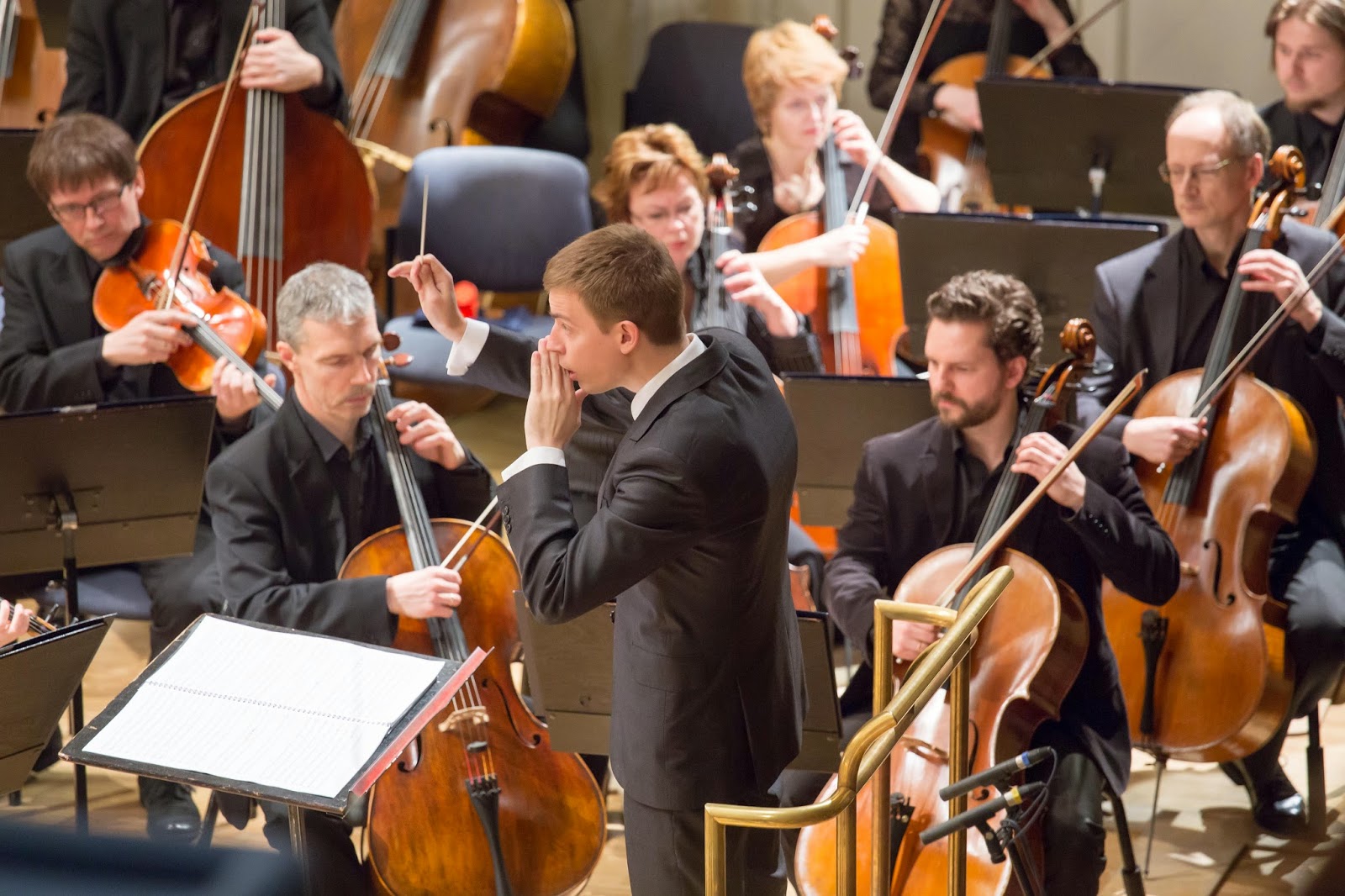 |
| Taavi Kull and Estonian National Symphony Orchestra photo Peeter Langovits |
The second work (the first to be played by the orchestra) was Lighting the Fireby Tatiana Kozlova-Johannes (born 1977) which was written for huge symphony orchestra. All five orchestral works that evening took advantage of the large forces available with lots of percussion, and the whole orchestra barely fitted onto the platform. Tatiana Kozlova-Johannes’ work was based on a passage from Clarissa Pinkola Estes‘ Women Who Run With Wolves (Myths and stories of the wild woman archetype). Starting from the slow moving texture of plucked strings and sustained wind with lots of tuned percussion, there was a sense of movement in the texture even though there was no sense of pulse, just a feeling of seething underneath which gradually built to an ear shattering climax. In the relatively close confines of the hall, it was one of the loudest unamplified sounds I have ever heard.
Meelis Vind (born 1964) has a background which combines classical and jazz, besides being a member of the Estonian National Symphony Orchestra for 29 seasons (he appeared again later in the programme as soloist). His work Phyrgian Landscape used the phyrgian mode and explored its use in classical, Indian and jazz music. The resulting synthesis had an attractive film-music quality with a jazz undertow and a certain feel of late Walton. But Vind seemed to extend his material beyond its natural length and the work could have been more concise.
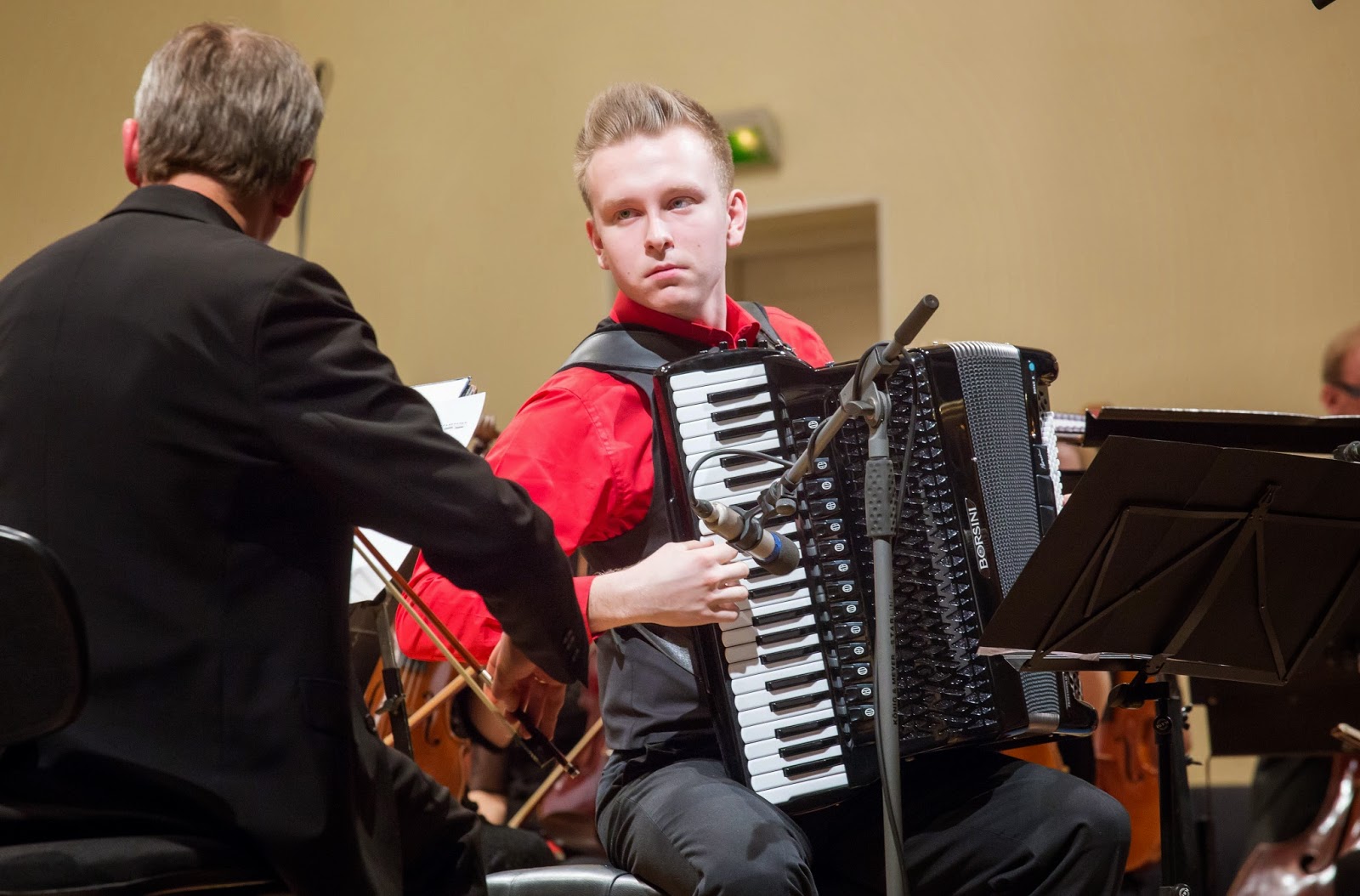 |
| Accordion player Henri Zibo and Estonian National Symphony Orchestra photo Peeter Langovits |
After the interval there were speeches and presentations (in Estonian) including one to composer Helena Tulve for the best work in last year’s festival. Then we heard Lost Space by Kristo Matson (born 1980), for organ and symphony orchestra with Aare-Paul Lattik playing the organ of the concert hall. Though the organ pat was complex, this was not an organ concerto, as Kristo Matson used the organ as part of the orchestra. (I have to confess that I was not entirely taken with the organ per se, but Matson’s challenging use of high notes may have pushed the instrument somewhat). The work had a fascination with textures, exploring the combinations of high instrument with the organ high in its range. The resulting work, often noisy at times, seemed a striking exercise in exploring the timbres of the organ/orchestra combination.
Riho Esko Maimets (born 1988) is actually Canadian though his family comes from Estonia and he currently lives in Tallinn and studied there, with Helena Tulve and Rene Eespere. His Accordion Concerto was performed by accordion player Henri Zibo. Opening with slow, sustained chords from the orchestra created from a slowly ascending scale, the soloist responded with a meditation on the same material. The piece developed this alternation, even as the material quickened in pace, so there was a sense of the soloist and the orchestra exchanging ideas. A quietly thoughtful cadenza, led to a perkier new section though still the exchange of ideas leading to a merging of the two. Though some of the material had folk-ish hints, the whole piece was an interesting re-thinking of the writing for the instrument as a soloist.
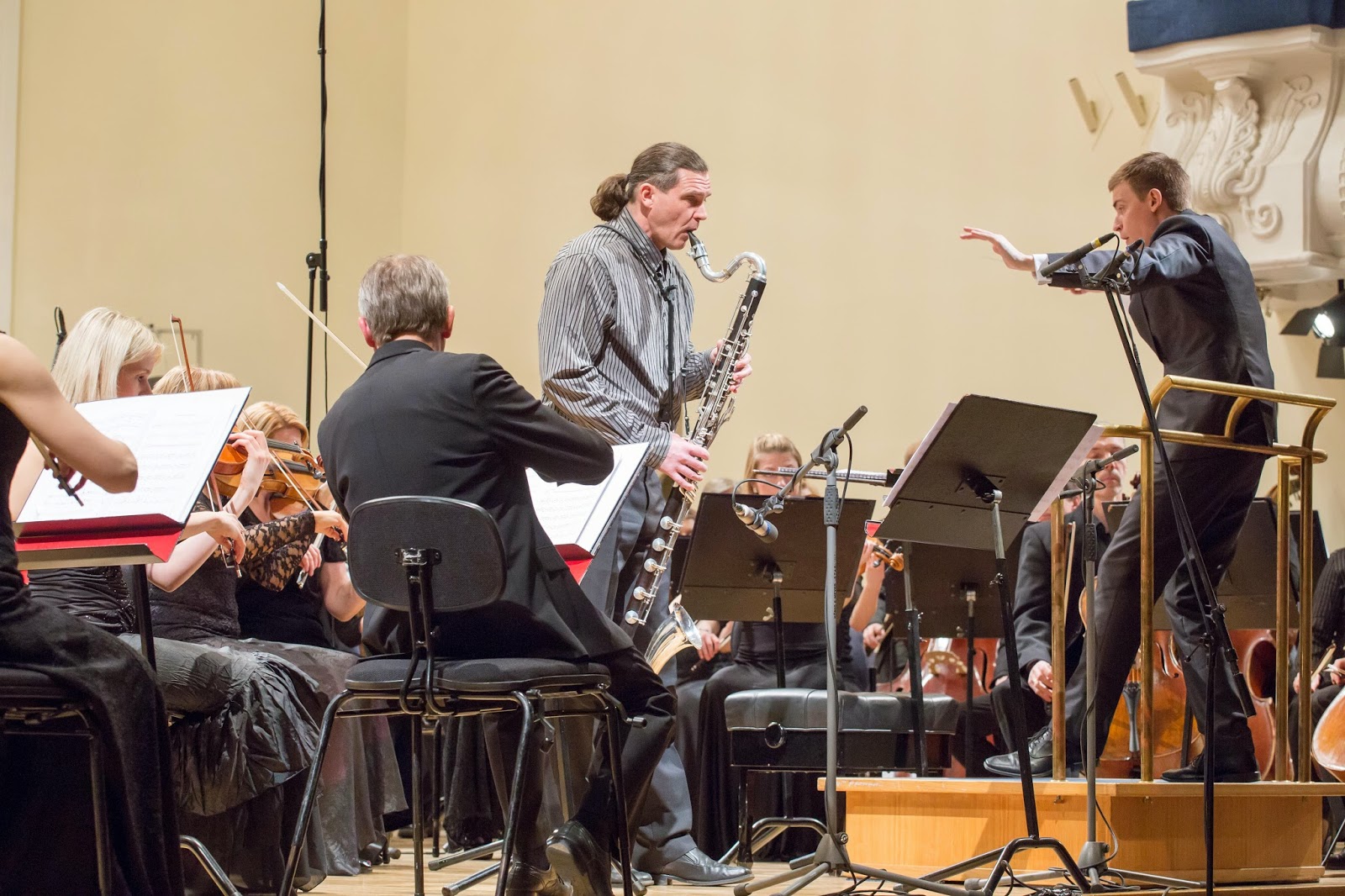 |
| Bass clarinet player Meelis Vind, Taavi Kull and Estonian National Symphony Orchestra photo Peeter Langovits |
The last work in the programme had another striking solo instrument, this time a bass clarinet. Meelis Vind returned, this time as soloist (and dedicatee) insilent songs for bass clarinet and orchestra by Tonu Korvits (born 1969). The three sections of the work were each based on a melody which Tonu Korvits linked to his Songbook of Dolores an invented work to which he has given a significant mythology and history. The opening movement used a wide-ranging rather modal, arpeggiated figure which explore the whole of the solo instrument’s range, over sustained orchestra textures. There was a careful balance in the piece, with the soloist always clear, as the movement developed as an extended meditation on the original theme. The middle movement had a similar feel, except the melody here had a rather exotic feel, whilst the final movement started with a long, highly structured orchestral section before the soloist introduced another exotic, folk-ish melody finishing very evocatively with Meelis Vind blowing overtones. Throughout the playing from Meelis Vind was superb.
Playing an entire evening of premieres is challenging, and the orchestra, under Taavi Kull, acquitted itself magnificently in all five works. None was easy and each received a confident and concentrated performance.
This was a long concert, lasting two hours 30 minutes (including interval) and I think it was a little over filled. I felt that one or two of the works were over long and could have benefited from a little tightening and pruning. Also, there was a sense of many of the composers using all the instruments because they were available rather than because they needed to.
But all in all this was a superb showcase for the vibrancy, variety and liveliness of the current Estonian music scene.
You can hear the concert for 30 days on the Estonian Klassika Raadio website (the site seems entirely in Estonian).
You can read about Day Two of my visit to Estonian Music Days on this blog.
http://www.planethugill.com/2015/04/estonian-music-days-day-one-introducing.html

 ENG
ENG